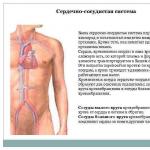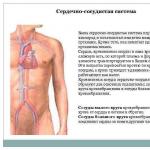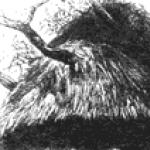Presentations on the anatomy of the cardiovascular system. Presentation on anatomy on the topic of the cardiovascular system prepared by
Presentation ON ANATOMY ON THE TOPIC: CARDIOVASCULAR SYSTEM Prepared by a student of the 21st Sat group of the KRVUZ Crimean Medical College Ibadlaeva Gulnara
 Cardiovascular System Your cardiovascular system transports oxygen and nutrients between tissues and organs. In addition, it helps remove toxins from the body. The heart, blood vessels and blood itself form a complex network through which plasma and formed elements are transported in your body. These substances are carried by the blood through the blood vessels, and the blood drives the heart, which works like a pump. The blood vessels of the cardiovascular system form two main subsystems: the vessels of the pulmonary circulation and the vessels of the systemic circulation. The pulmonary circulation vessels carry blood from the heart to the lungs and back. The vessels of the systemic circulation connect the heart to all other parts of the body.
Cardiovascular System Your cardiovascular system transports oxygen and nutrients between tissues and organs. In addition, it helps remove toxins from the body. The heart, blood vessels and blood itself form a complex network through which plasma and formed elements are transported in your body. These substances are carried by the blood through the blood vessels, and the blood drives the heart, which works like a pump. The blood vessels of the cardiovascular system form two main subsystems: the vessels of the pulmonary circulation and the vessels of the systemic circulation. The pulmonary circulation vessels carry blood from the heart to the lungs and back. The vessels of the systemic circulation connect the heart to all other parts of the body.

 Blood vessels carry blood between the heart and various tissues and organs of the body. The following types of blood vessels exist: arteries arterioles capillaries venules and veins Arteries and arterioles carry blood away from the heart. Veins and venules deliver blood back to the heart.
Blood vessels carry blood between the heart and various tissues and organs of the body. The following types of blood vessels exist: arteries arterioles capillaries venules and veins Arteries and arterioles carry blood away from the heart. Veins and venules deliver blood back to the heart.
 Arteries and arterioles Arteries carry blood from the ventricles of the heart to other parts of the body. They have a large diameter and thick elastic walls that can withstand very high blood pressure. Before connecting with capillaries, arteries divide into thinner branches called arterioles. Capillaries are the smallest blood vessels that connect arterioles to venules. Due to the very thin wall of the capillaries, they allow the exchange of nutrients and other substances (such as oxygen and carbon dioxide) between the blood and the cells of various tissues. Depending on the need for oxygen and other nutrients, different tissues have different numbers of capillaries. Tissues such as muscles consume large amounts of oxygen and therefore have a dense network of capillaries. On the other hand, tissues with a slow metabolism (such as the epidermis and cornea) do not have capillaries at all. The human body has a lot of capillaries: if they could be unwoven and pulled into one line, then its length would be from 40,000 to 90,000 km!
Arteries and arterioles Arteries carry blood from the ventricles of the heart to other parts of the body. They have a large diameter and thick elastic walls that can withstand very high blood pressure. Before connecting with capillaries, arteries divide into thinner branches called arterioles. Capillaries are the smallest blood vessels that connect arterioles to venules. Due to the very thin wall of the capillaries, they allow the exchange of nutrients and other substances (such as oxygen and carbon dioxide) between the blood and the cells of various tissues. Depending on the need for oxygen and other nutrients, different tissues have different numbers of capillaries. Tissues such as muscles consume large amounts of oxygen and therefore have a dense network of capillaries. On the other hand, tissues with a slow metabolism (such as the epidermis and cornea) do not have capillaries at all. The human body has a lot of capillaries: if they could be unwoven and pulled into one line, then its length would be from 40,000 to 90,000 km!
 Venules and Veins Venules are tiny vessels that connect capillaries to veins, which are larger than venules. Veins run almost parallel to the arteries and carry blood back to the heart. Unlike arteries, veins have thinner walls that contain less muscle and elastic tissue. The Importance of Oxygen The cells of your body need oxygen, and it is the blood that carries oxygen from the lungs to various organs and tissues. When you breathe, oxygen passes through the walls of special air sacs (alveoli) in the lungs and is captured by special blood cells (red blood cells). Oxygen-enriched blood travels through the pulmonary circulation to the heart, which pumps it through the systemic circulation to other parts of the body. Once in different tissues, the blood gives up the oxygen it contains and takes up carbon dioxide instead. Blood saturated with carbon dioxide returns to the heart, which pumps it again to the lungs, where it is freed from carbon dioxide and saturated with oxygen, thereby completing the gas exchange cycle.
Venules and Veins Venules are tiny vessels that connect capillaries to veins, which are larger than venules. Veins run almost parallel to the arteries and carry blood back to the heart. Unlike arteries, veins have thinner walls that contain less muscle and elastic tissue. The Importance of Oxygen The cells of your body need oxygen, and it is the blood that carries oxygen from the lungs to various organs and tissues. When you breathe, oxygen passes through the walls of special air sacs (alveoli) in the lungs and is captured by special blood cells (red blood cells). Oxygen-enriched blood travels through the pulmonary circulation to the heart, which pumps it through the systemic circulation to other parts of the body. Once in different tissues, the blood gives up the oxygen it contains and takes up carbon dioxide instead. Blood saturated with carbon dioxide returns to the heart, which pumps it again to the lungs, where it is freed from carbon dioxide and saturated with oxygen, thereby completing the gas exchange cycle.
 How the Heart Works To pump blood through the heart, its chambers undergo alternating relaxations (diastole) and contractions (systole), during which the chambers fill with blood and push it out accordingly. The right atrium of the heart receives oxygen-poor blood from two main veins: the superior vena cava and the inferior vena cava, as well as from the smaller coronary sinus, which collects blood from the walls of the heart itself. When the right atrium contracts, blood enters the right ventricle through the tricuspid valve. When the right ventricle is sufficiently filled with blood, it contracts and pumps blood through the pulmonary arteries into the pulmonary circulation. Blood enriched with oxygen in the lungs travels through the pulmonary veins to the left atrium. Once filled with blood, the left atrium contracts and pushes blood through the mitral valve into the left ventricle. After filling with blood, the left ventricle contracts and pumps blood into the aorta with great force. From the aorta, blood enters the vessels of the systemic circulation, carrying oxygen to all cells of the body.
How the Heart Works To pump blood through the heart, its chambers undergo alternating relaxations (diastole) and contractions (systole), during which the chambers fill with blood and push it out accordingly. The right atrium of the heart receives oxygen-poor blood from two main veins: the superior vena cava and the inferior vena cava, as well as from the smaller coronary sinus, which collects blood from the walls of the heart itself. When the right atrium contracts, blood enters the right ventricle through the tricuspid valve. When the right ventricle is sufficiently filled with blood, it contracts and pumps blood through the pulmonary arteries into the pulmonary circulation. Blood enriched with oxygen in the lungs travels through the pulmonary veins to the left atrium. Once filled with blood, the left atrium contracts and pushes blood through the mitral valve into the left ventricle. After filling with blood, the left ventricle contracts and pumps blood into the aorta with great force. From the aorta, blood enters the vessels of the systemic circulation, carrying oxygen to all cells of the body.

The heart has the shape of a cone, flattened in the anteroposterior direction. It distinguishes between the top and the base. The apex is the pointed part of the heart, directed down and to the left and slightly forward. The base is the expanded part of the heart, facing up and to the right and slightly back. It consists of strong elastic tissue - the heart muscle (myocardium), which contracts rhythmically throughout life, sending blood through the arteries and capillaries to the tissues of the body.

Structure of the Heart The HEART is a powerful muscular organ that pumps blood through a system of cavities (chambers) and valves into a closed distribution system called the circulatory system. The wall of the heart consists of three layers: the internal endocardium, the middle endocardium - the myocardium and the outer myocardium - the epicardium. epicardium

The endocardium lines the inside surface of the chambers of the heart; it is formed by a special type of epithelial tissue - endothelium. The endothelium has a very smooth, shiny surface, which reduces friction as blood moves through the heart. The myocardium makes up the bulk of the heart wall. It is formed by striated cardiac muscle tissue, the fibers of which, in turn, are arranged in several layers. The atrial myocardium is much thinner than the ventricular myocardium. The myocardium of the left ventricle is three times thicker than the myocardium of the right ventricle. The degree of development of the myocardium depends on the amount of work performed by the chambers of the heart. The myocardium of the atria and ventricles is separated by a layer of connective tissue (annulus fibrosus), which makes it possible to alternately contract the atria and ventricles. The epicardium is a special serous membrane of the heart, formed by connective and epithelial tissue.




Vessels of the circulatory system Arteries carry blood from the heart, and veins return blood to the heart. Between the arterial and venous sections of the circulatory system there is a microvasculature connecting them, including arterioles, venules, and capillaries. ARTERIES CAPILLARIES VEINS

ARTERIES The wall of the artery consists of three membranes: inner, middle and outer. The inner lining is the endothelium (squamous epithelium with a very smooth surface). The middle layer is formed by smooth muscle tissue and contains well-developed elastic fibers. Smooth muscle fibers change the lumen of the artery. Elastic fibers provide firmness, elasticity and strength to the walls of arteries. The outer shell consists of loose fibrous connective tissue, which plays a protective role and helps fix the arteries in a certain position. As they move away from the heart, the arteries branch strongly, eventually forming the smallest ones - arterioles.


Veins The second feature of veins is the large number of venous valves on the inner wall. They are arranged in pairs in the form of two semilunar folds. Venous valves prevent blood from flowing back in the veins when skeletal muscles work. There are no venous valves in the superior vena cava, pulmonary veins, veins of the brain and heart. The structure of the wall of veins is fundamentally the same as that of arteries. But the peculiarity is the significantly smaller wall thickness due to the thinness of the middle layer. It has much less muscle and elastic fibers due to low blood pressure in the veins.


Cardiac cycle. The sequence of contractions of the chambers of the heart is called the cardiac cycle. During the cycle, each of the four chambers goes through not only a contraction phase (systole), but also a relaxation phase (diastole). The atria contract first: first the right one, almost immediately followed by the left one. These contractions ensure that the relaxed ventricles are quickly filled with blood. Then the ventricles contract, forcefully pushing out the blood they contain. At this time, the atria relax and fill with blood from the veins. Each such cycle lasts on average 6/7 seconds.

Heart work in numbers In children and adults, the heart contracts at different frequencies: in children under one year of contractions per minute, at 10 years old 90, and at 20 years old and older 6070; after 60 years, the number of contractions becomes more frequent and reaches In athletes-runners, while running at sports competitions, the heart rate can reach up to 250 per minute; after running, the heart gradually calms down, and soon its normal rhythm of contractions is established. With each contraction, the heart throws out about 60–75 ml of blood, and per minute (with an average contraction frequency of 70 per minute) – 4–5 liters. Over 70 years, the heart produces more than 2.5 billion contractions and pumps approximately 156 million liters of blood. The work of the heart, like any other work, is measured by multiplying the weight of the lifted load (in kilograms) by the height (in meters). Let's try to determine its work. During the day, if a person does not do hard work, the heart contracts more than once; per year about once, and in 70 years of life almost once. What an impressive figure of three billion cuts! Now multiply the heart rate by the amount of blood ejected, and you will see what a huge amount of it it pumps. After making the calculation, you will be convinced that in an hour the heart pumps about 300 liters of blood, in a day over 7000 liters, in a year, and in 70 years of life liters. The blood pumped by the heart during a person's life can fill 4,375 railway tanks. If the heart pumped not blood, but water, then from the water it pumped over 70 years it would be possible to create a lake 2.5 m deep, 7 km wide and 10 km long. The work of the heart is very significant. So, with one beat, work is done with the help of which you can lift a load of 200 g to a height of 1 m. In 1 minute, the heart would lift this load 70 m, i.e. to the height of almost a twenty-story building. If it were possible to use the work of the heart, then in 8 hours it would be possible to lift a person to the height of the building of Moscow University (about 240 m), and in 3031 days to the top of Chomolungma, the highest point on the globe (8848 m)!

BLOOD PRESSURE The rhythmic work of the heart creates and maintains a pressure difference in the blood vessels. When the heart contracts, blood is forced into the arteries under pressure. During the passage of blood through the vessels, pressure energy is wasted. Therefore, blood pressure gradually decreases. In the aorta it is highest mm.Hg, in arteries – up to 120 mmHg, in capillaries up to 20, and in the vena cava from 3-8 mmHg. to minimum (-5) (below atmospheric). According to the law of physics, liquid moves from an area with higher pressure to an area with lower pressure. Arterial blood pressure is not a constant value. It pulsates in time with the contractions of the heart: at the moment of systole, the pressure rises to mmHg. (systolic pressure), and during diastole it decreases to mmHg. (diastolic). These pulse pressure fluctuations occur simultaneously with pulse fluctuations of the arterial wall. A person's blood pressure is measured. A person's blood pressure is measured in the brachial artery, comparing it with atmospheric pressure. A person's blood pressure is measured

HOW TO MEASURE BLOOD PRESSURE Air is pumped into the pressure gauge cuff until the pulse on the wrist disappears. Now the brachial artery is compressed by great external pressure and blood does not flow through it. Then, gradually releasing air from the cuff, watch for the appearance of a pulse. At this moment, the pressure in the artery becomes slightly greater than the pressure in the cuff, and the blood, and with it the pulse wave, begins to reach the wrist. The pressure gauge readings at this time will characterize the blood pressure in the brachial artery.

PULSE Pulse. When the ventricles contract, blood is ejected into the aorta, increasing its pressure. The wave that arises in its wall propagates at a certain speed from the aorta to the arteries. Rhythmic oscillations of the arterial wall. Caused by an increase in pressure in the aorta during systole, called the pulse. The pulse can be detected in places where large arteries come close to the surface of the body (wrist, temples, sides of the neck).

“Muscle work” - Leg muscles. The structure and function of skeletal muscles. Which letter represents smooth and striated muscles? Physical inactivity. Muscles of the torso at the back. Presentation for 8th grade Protsenko L.V. A-; B-. What is indicated by the numbers 1-; 2-; 3-; 4-. Basic concepts. Independent work: p. 69, Motor unit (MU).
"The Growth of Man" - Judgment Day: Friday, November 13, 2026. Coherence? Possible biological basis of the “Global Crisis”. H. von Foester. …”. I.S. Shklovsky, 1980. N = C / (2025-T) billions, where T is the current time, C is a constant (186 people*years). Nt = 186953/(38 - t). Biological basis of the “Global Crisis”.
“Analyzers” - Studying new material. XI. Temperature. What is the structure of the analyzer? XII. Teaching methods. VIII. Lesson plan. List the analyzers you know. "Brain Tentacles" Tactile.
“Internal environment of the body” - The internal environment of the body has a relative constancy of composition and physicochemical properties. Blood Lymph. The relationship between the components of the internal environment of the body. Tissue fluid. Internal environment of the body Tissue Blood Lymph (intercellular) fluid. Blood Plasma Formed elements: Blood platelets platelets Cells Erythrocytes Leukocytes.
“Bid structure” - Internodes. Opposite (ash, lilac, elderberry). A flower bud is the germ of a reproductive shoot. (Example: elderberry, lilac, willow). Knot. Oak. The structure of a vegetative shoot. Whorled (elodea). Selezneva Alena. Linden. Leaf mosaic. Internal structure of the kidney. Green leaves. Internal structure of a vegetative bud.
“Endocrine glands” - Hormones of the sex glands. ENDOCRINE SYSTEM. Glands of internal and mixed secretion. Thyroid. SIMULATOR 1. Pituitary gland 2. Adrenal glands 3. Thyroid gland 4. Pancreas 5. Sex glands. Municipal educational institution Kazachinskaya secondary school. Lesson plan. Lesson objectives. Insulin Adrenaline Thyroxine Norepinephrine Vasopressin Estradiol Testosterone Endorphin.
THE CARDIOVASCULAR SYSTEM
1. Structure
cardiovascular
- Heart.
- Blood vessels.
- Cardiac cycle
- Circulation circles
- Blood pressure
- Pulse
2. Work of the heart and blood vessels:
- Heart
- Blood vessels
The heart has the shape of a cone, flattened in the anteroposterior direction. It distinguishes between the top and the base. The apex is the pointed part of the heart, directed down and to the left and slightly forward. The base is the expanded part of the heart, facing up and to the right and slightly back. It consists of strong elastic tissue - the heart muscle (myocardium), which contracts rhythmically throughout life, sending blood through the arteries and capillaries to the tissues of the body.
Structure of the heart
The HEART is a powerful muscular organ that pumps blood through a system of cavities (chambers) and valves into a closed distribution system called the circulatory system.
The heart wall consists of three layers:
internal - endocardium,
middle - myocardium and
external - epicardium.
Endocardium Endocardium It lines the inside surface of the chambers of the heart; it is formed by a special type of epithelial tissue - endothelium. The endothelium has a very smooth, shiny surface, which reduces friction as blood moves through the heart. Myocardium makes up the bulk of the heart wall. It is formed by striated cardiac muscle tissue, the fibers of which, in turn, are arranged in several layers. The atrial myocardium is much thinner than the ventricular myocardium. The myocardium of the left ventricle is three times thicker than the myocardium of the right ventricle. The degree of development of the myocardium depends on the amount of work performed by the chambers of the heart. The myocardium of the atria and ventricles is separated by a layer of connective tissue (annulus fibrosus), which makes it possible to alternately contract the atria and ventricles. Epicard- This is a special serous membrane of the heart, formed by connective and epithelial tissue. Heart chambers Heart valvesThe functioning of the heart valves ensures one-way movement
in heart.
Blood vessels are a closed system of hollow elastic tubes of various structures, diameters and mechanical properties. Vessels of the circulatory system Arteries carry blood from the heart, and veins return blood to the heart. Between the arterial and venous sections of the circulatory system there is a microvasculature connecting them, including arterioles, venules, and capillaries.
CAPILLARIES
ARTERIES The wall of the artery consists of three membranes: inner, middle and outer. The inner lining is the endothelium (squamous epithelium with a very smooth surface). The middle layer is formed by smooth muscle tissue and contains well-developed elastic fibers. Smooth muscle fibers change the lumen of the artery. Elastic fibers provide firmness, elasticity and strength to the walls of arteries. The outer shell consists of loose fibrous connective tissue, which plays a protective role and helps fix the arteries in a certain position. As they move away from the heart, the arteries branch strongly, eventually forming the smallest ones - arterioles. CAPILLARIES The thin wall of capillaries is formed by only one layer of flat endothelial cells. Blood gases, metabolic products, nutrients, vitamins, hormones and white blood cells (if necessary) easily pass through it. Veins The second feature of veins is the large number of venous valves on the inner wall. They are arranged in pairs in the form of two semilunar folds. Venous valves prevent blood from flowing back in the veins when skeletal muscles work. There are no venous valves in the superior vena cava, pulmonary veins, veins of the brain and heart.
The structure of the wall of veins is fundamentally the same as that of arteries. But the peculiarity is the significantly smaller wall thickness due to the thinness of the middle layer. It has much less muscle and elastic fibers due to low blood pressure in the veins.
CIRCLES OF BLOOD CIRCULATION Cardiac cycle. The sequence of contractions of the chambers of the heart is called the cardiac cycle. During the cycle, each of the four chambers goes through not only a contraction phase (systole), but also a relaxation phase (diastole). The atria contract first: first the right one, almost immediately followed by the left one. These contractions ensure that the relaxed ventricles are quickly filled with blood. Then the ventricles contract, forcefully pushing out the blood they contain. At this time, the atria relax and fill with blood from the veins. Each such cycle lasts on average 6/7 seconds. Heart work in numbers In children and adults, the heart contracts at different frequencies: in children under one year old - 100-200 beats per minute, at 10 years old - 90, and at 20 years old and older - 60-70; after 60 years, the number of contractions becomes more frequent and reaches 90-95. For athletes-runners, while running at sports competitions, the heart rate can reach up to 250 per minute; when the running is over, the heart gradually calms down, and soon its normal rhythm of contractions is established. With each contraction, the heart throws out about 60–75 ml of blood, and per minute (with an average contraction frequency of 70 per minute) – 4–5 liters. Over 70 years, the heart produces more than 2.5 billion contractions and pumps approximately 156 million liters of blood. The work of the heart, like any other work, is measured by multiplying the weight of the lifted load (in kilograms) by the height (in meters). Let's try to determine its work. During the day, if a person does not do hard work, the heart contracts over 100,000 times; per year - about 40,000,000 times, and over 70 years of life - almost 3,000,000,000 times. What an impressive figure - three billion cuts! Now multiply the heart rate by the amount of blood ejected, and you will see what a huge amount of it it pumps. After making the calculation, you will be convinced that in an hour the heart pumps about 300 liters of blood, in a day - over 7000 liters, in a year - 2,500,000, and in 70 years of life - 175,000,000 liters. The blood pumped by the heart during a person's life can fill 4,375 railway tanks. If the heart pumped not blood, but water, then from the water it pumped over 70 years it would be possible to create a lake 2.5 m deep, 7 km wide and 10 km long. The work of the heart is very significant. So, with one beat, work is done with the help of which you can lift a load of 200 g to a height of 1 m. In 1 minute, the heart would lift this load 70 m, i.e. to the height of almost a twenty-story building. If it were possible to use the work of the heart, then in 8 hours it would be possible to lift a person to the height of the Moscow University building (about 240 m), and in 30-31 days to the top of Chomolungma - the highest point on the globe (8848 m)! BLOOD PRESSURE The rhythmic work of the heart creates and maintains a pressure difference in the blood vessels. When the heart contracts, blood is forced into the arteries under pressure. During the passage of blood through the vessels, pressure energy is wasted. Therefore, blood pressure gradually decreases. In the aorta it is highest 120-150 mmHg, in arteries - up to 120 mmHg, in capillaries up to 20, and in the vena cava from 3-8 mmHg. to minimum (-5) (below atmospheric). According to the law of physics, liquid moves from an area with higher pressure to an area with lower pressure. Arterial blood pressure is not a constant value. It pulsates in time with the contractions of the heart: at the moment of systole, the pressure rises to 120-130 mmHg. (systolic pressure), and during diastole it decreases to 80-90 mmHg. (diastolic). These pulse pressure fluctuations occur simultaneously with pulse fluctuations of the arterial wall. A person's blood pressure is measured in the brachial artery, comparing it with atmospheric pressure. HOW TO MEASURE BLOOD PRESSURE Air is pumped into the pressure gauge cuff until the pulse on the wrist disappears. Now the brachial artery is compressed by great external pressure and blood does not flow through it. Then, gradually releasing air from the cuff, watch for the appearance of a pulse. At this moment, the pressure in the artery becomes slightly greater than the pressure in the cuff, and the blood, and with it the pulse wave, begins to reach the wrist. The pressure gauge readings at this time will characterize the blood pressure in the brachial artery. PULSE Pulse. When the ventricles contract, blood is ejected into the aorta, increasing its pressure. The wave that arises in its wall propagates at a certain speed from the aorta to the arteries. Rhythmic oscillations of the arterial wall. Caused by an increase in pressure in the aorta during systole, called the pulse.
The pulse can be detected in places where large arteries come close to the surface of the body (wrist, temples, sides of the neck).

The cardiovascular system
(abbreviated as CSS) is a system of organs that ensure blood circulation throughout the body.
The cardiovascular system includes blood vessels, veins (blood flows through
direction towards the heart), arteries (blood drains from the heart and goes to the organs), capillaries, and the main circulatory organ - the heart.

Meaning
The main importance of the cardiovascular system is to supply blood to organs and tissues. Blood continuously moves through the vessels, which gives it the opportunity to perform all vital functions. The circulatory system includes the heart and blood vessels - circulatory and lymphatic.
The heart is a biological pump, thanks to which blood moves through a closed system of blood vessels. Every minute the heart pumps about 6 liters of blood into the circulatory system per day
Over 8 thousand liters, during life (with an average duration of 70 years) - almost 175 million liters of blood.

Diagram of the location of the largest blood vessels in the human body. Arteries are shown in red, veins in blue.

Location of the heart
The heart is in
chest behind the sternum and in front of the descending part of the arch
aorta and esophagus. It is attached to the central ligament
diaphragm muscles. WITH
There is one lung on both sides. At the top are the main blood vessels and the division of the trachea.
into the two main bronchi.

The heart is a hollow muscular organ capable of rhythmic
contractions due to the conduction system of the heart
(specialized muscle fibers), as well as ensuring continuous movement of blood inside the vessels. The human heart consists of two completely separated halves, each of which has a ventricle and an atrium.
Vessels are a system of hollow elastic tubes of various structures, diameters and mechanical properties filled with blood.

Structure of the heart
The heart weighs about 300 g and |
|
shaped like a grapefruit; |
|
has two atria, two |
|
ventricle and four valves; |
|
receives blood from two vena cavae and |
|
four pulmonary veins, and |
|
throws it into the aorta and pulmonary |
|
trunk. The heart pumps 9 liters |
|
blood per day, making from 60 to 160 |
|
beats per minute. |
|
The heart is covered with thick |
|
fibrous membrane - |
|
pericardium, forming |
|
serous cavity filled |
|
a small amount |
|
liquid, which prevents |
|
friction during its contraction. |
|
The heart consists of two pairs |
|
chambers - atria and |
|
ventricles, which act as |
|
independent pumps. Right |
|
half the heart is pumping |
|
venous, rich in carbon dioxide |
|
gases the blood through the lungs; This - |
|
pulmonary circulation. Left |
|
half throws away saturated |
|
oxygenated blood coming from |
|
lungs, in a large circle |
|
blood circulation |

Functions of the SSS
The main function of the cardiovascular system is to move blood, which is ensured by heart contractions, through a closed chain of blood vessels.
Blood carries substrates necessary for their normal functioning to all cells and removes their waste products. All these substances enter the bloodstream and exit through the capillaries into the intercellular fluid.
In addition to the system of blood vessels, there is a system lymphatic vessels, which collects fluid and proteins from the intercellular space and transfers them to the circulatory system.

Valves
The valves ensure that blood flows through the heart in only one direction, preventing it from returning. Valves consist of two or three leaflets that close to close the passage once blood has passed through the valve. The mitral and aortic valves control the flow of oxygenated blood on the left side; The tricuspid valve and pulmonary valve control the passage of oxygen-deprived blood on the right side.
The inside of the heart cavity is lined with endocardium and is divided lengthwise into two halves by continuous interatrial and interventricular septa.

Heart automaticity system
As you know, the heart can contract or work outside the body, i.e. isolated. True, it can do this for a short time. When normal conditions (nutrition and oxygen) are created for its operation, it can shrink almost indefinitely. This ability of the heart is associated with a special structure and metabolism. In the heart, there are working muscles, represented by striated muscle, and special tissue in which excitation occurs and is carried out.

The special tissue consists of poorly differentiated muscle fibers. In certain areas of the heart, a significant number of nerve cells, nerve fibers and their endings have been found, which here form a nerve network. Clusters of nerve cells in certain areas of the heart are called nodes. Nerve fibers from the autonomic nervous system (vagus and sympathetic nerves) approach these nodes. In higher vertebrates, including humans, atypical tissue consists of:
1. located in the appendage of the right atrium, the sinoatrial node, which is the leading node (“pacemaker” of the first order) and sends impulses to the two atria, causing their systole;
2. atrioventricular node (atrioventricular node), located in the wall of the right atrium near the septum between the atria and ventricles;





